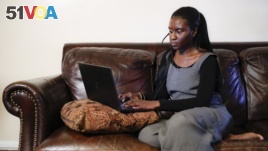19 August 2020
Joseph Ortiz walked to the home of a man who was tested COVID-19. The test showed the man has the disease.
Ortiz was unsure what to expect during his visit.

Maryama Diaw, a contact tracer with New York City's Health + Hospitals battling the coronavirus pandemic, sets up her remote calling system at her home before reaching out to potential patients Wednesday, Aug. 5, 2020, in New York. (AP Photo/John Minchillo)
The person had not answered telephone calls from New York City's contact tracing program. New York officials set up the program to keep the coronavirus from spreading. The goal was to get new diagnosed people to identify others they might have infected before the virus spreads further.
"You never know what you're going to get," Ortiz told The Associated Press. He added that "sometimes you have people who are really appreciative...they like that we're out here trying to end the pandemic."
Such is the work of what appears to be the biggest contact tracing effort in any city in the United States. New York has over 3,000 people making phone calls, going door to door, and asking people about their health.
New York Mayor Bill de Blasio has called the effort an "amazing success." The city says it is now meeting its goal of reaching about 90 percent of all newly diagnosed people and completing interviews with 75 percent.
But in the program's first two months, more than 11,000 infected people — 50 percent of new cases — did not give any names of others they might have exposed. When people have identified contacts, tracers have done interviews with 6 in 10 of them. That is below the target of New York officials.
Comparing U.S. state and city contact tracing programs is difficult because they vary or differ widely in what they release. However, some public health experts say the numbers that New York reports are looking good.
Program director Ted Long knows there is more work to do. Long is a doctor and an official with the city-operated hospital system Health + Hospitals. He estimates the tracers' efforts have prevented thousands of coronavirus cases and helped keep new infections, hospitalizations and deaths at low levels.
Newly confirmed cases rose past 6,000 on some days in April; they now average about 200 a day because of more testing.
"That's what tells me that what we are doing is working," Long said.
Contact tracing is an old, highly respected public health technique. But the pandemic is testing it once again in many countries around the world.
The pain is hard for the U.S. city that has reported more deaths from COVID-19, the disease caused by the coronavirus, than any other.
Making calls from her home in East Harlem, tracer Maryama Diaw says she tries to "be sensitive and...talk to the person as a human being."
Recently when a woman tested positive for the disease, Diaw said, she put down her written questions and asked the woman "Are you doing OK?"
"We talked for a little bit, like person to person," said Diaw, a student in public health.
The U.S. Centers for Disease Control and Prevention's director has estimated the country will need 100,000 tracers. By the end of July, the total was over 41,000. That number is based on information collected by National Public Radio and Johns Hopkins University in Maryland.
As a nation, "we're not in a good place," said Lori Tremmel Freeman. She is chief executive officer of the National Association of County and City Health Officials. She added that New York City was doing well.
The city already had hundreds of people tracing other infectious diseases before the pandemic. But COVID-19 took the work to a level they had never tried before, said deputy health commissioner Demetre Daskalakis.
New York City appears to have the biggest city-level program. By comparison, 2,600 tracers are covering nearly all of Los Angeles County in California. Chicago says it has over 200 tracers now and expects the number to grow to about 800 by the middle of September.
L.A. County health officials says their program is "going well." It completes interviews with about 50 percent of all new cases and with nearly 66 percent of all new contacts.
I'm Susan Shand.
The Associated Press reported this story. Susan Shand adapted it for Learning English. George Grow was the editor.
_______________________________________________________________
Words in This Story
tracing - adj. the act of following something or some people to reach others
diagnose - v. to come to a conclusion about the cause of medical issue
appreciative - adj. showing thankfulness
pandemic - n. a contagious illness that spreads to tore countries
interview - n. to ask someone questions
technique - n. the way someone undertakes a job or activity